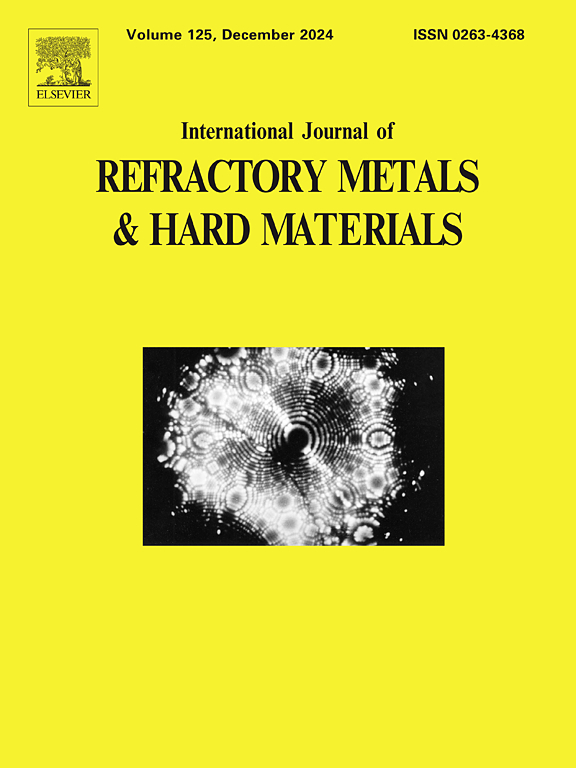Interfacial stabilization for electron beam welding of molybdenum and Kovar alloy with Permalloy addition
IF 4.6
2区 材料科学
Q2 MATERIALS SCIENCE, MULTIDISCIPLINARY
International Journal of Refractory Metals & Hard Materials
Pub Date : 2025-07-03
DOI:10.1016/j.ijrmhm.2025.107307
引用次数: 0
Abstract
No continuous brittle phase precipitates at the fracture location of the molybdenum/Kovar alloy electron beam welded joint, indicating that unstable phase interfaces resulting from solid-state phase transitions constitute the fundamental cause of joint brittleness. To inhibit solid-state phase transitions and optimize interfacial stability, Permalloy was added to the weld. The original solid-state eutectoid reaction (R(Fe5Mo3) → α-Fe + μ(Fe3Mo2)) was successfully replaced by a liquid-phase eutectic reaction (L → γ-Ni + MoNi). Since the eutectic γ-Ni + MoNi in contact with α-Mo precipitates directly from the liquid phase, no habitus growth occurs between the products and the parent phase during solid-state phase transitions. The eutectic nuclei grow along lattice planes exhibiting minimal distortion with α-Mo to minimize interface energy with adjacent phases. After adding Permalloy, the lattice misfit at the α-Mo/MoNi and α-Mo/γ-Ni interfaces is reduced to 11.2 % and 6.3 %, respectively, significantly lower than the excessive misfits of 22.1 % and 30.6 % observed at the original α-Mo/eutectoid α-Fe + μ(Fe3Mo2) interfaces without Permalloy addition. The transformation of the primary phase interface within the weak zone from incoherent to nearly coherent significantly enhances the mechanical properties of the welded joint, resulting in a tensile strength of 312 MPa, a 23 % increase compared to joints welded without Permalloy addition.

添加坡莫合金对钼与科瓦合金电子束焊接界面的稳定
钼/Kovar合金电子束焊接接头断口处没有连续的脆性相析出,表明固态相变导致的相界面不稳定是接头脆性的根本原因。为了抑制固相转变和优化界面稳定性,在焊缝中加入了坡莫合金。原来的固态共晶反应(R(Fe5Mo3)→α-Fe + μ(Fe3Mo2))成功地被液相共晶反应(L→γ-Ni + MoNi)所取代。由于与α-Mo接触的共晶γ-Ni + MoNi直接从液相析出,因此在固相转变过程中产物与母相之间不发生惯相生长。共晶核沿晶格面生长,α-Mo的畸变最小,与相邻相的界面能最小。添加坡莫合金后,α-Mo/MoNi界面和α-Mo/γ-Ni界面的晶格失配率分别降至11.2%和6.3%,显著低于未添加坡莫合金时α-Mo/共析α-Fe + μ(Fe3Mo2)界面的过度失配率22.1%和30.6%。弱区初相界面由非相干转变为近相干,显著提高了焊接接头的力学性能,抗拉强度达到312 MPa,比未添加坡莫合金的焊接接头提高23%。
本文章由计算机程序翻译,如有差异,请以英文原文为准。
求助全文
约1分钟内获得全文
求助全文
来源期刊
CiteScore
7.00
自引率
13.90%
发文量
236
审稿时长
35 days
期刊介绍:
The International Journal of Refractory Metals and Hard Materials (IJRMHM) publishes original research articles concerned with all aspects of refractory metals and hard materials. Refractory metals are defined as metals with melting points higher than 1800 °C. These are tungsten, molybdenum, chromium, tantalum, niobium, hafnium, and rhenium, as well as many compounds and alloys based thereupon. Hard materials that are included in the scope of this journal are defined as materials with hardness values higher than 1000 kg/mm2, primarily intended for applications as manufacturing tools or wear resistant components in mechanical systems. Thus they encompass carbides, nitrides and borides of metals, and related compounds. A special focus of this journal is put on the family of hardmetals, which is also known as cemented tungsten carbide, and cermets which are based on titanium carbide and carbonitrides with or without a metal binder. Ceramics and superhard materials including diamond and cubic boron nitride may also be accepted provided the subject material is presented as hard materials as defined above.

 求助内容:
求助内容: 应助结果提醒方式:
应助结果提醒方式:


